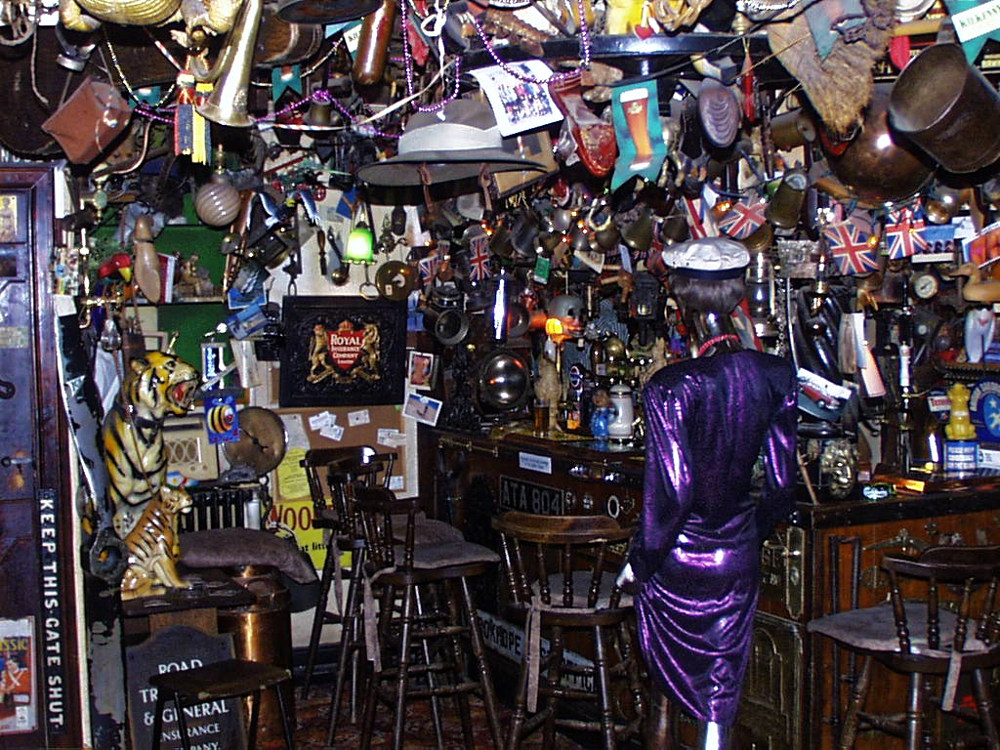
Before departing we looked at the station, now a terminus of the South Tynedale Railway, the highest narrow gauge railway in Britain. As a standard gauge line this was connected to the national network until 1976.
We pushed our bikes up the cobbles again and took the road to Nenthead where all the cyclists stopped for refreshments at the pub, which is also a stamping point. This section was harder than we expected and we didn’t reach Allenheads until lunchtime, having cycled about 12 miles!
The pub at Allenheads is amazing. “Course you can – if you’re happy, I’m happy” was the response when I asked if was alright to eat our sandwiches with our drinks. The landlord then came out to regale the cyclists with jokes, dashing back in periodically to serve customers.
As we sat outside, the sun looked to be breaking through the mist but gave up just as it seemed it would win the battle and it became progressively colder and mistier as we rode east past the moorland mining relics. We gained the Waskerley Way near Stanhope, an old railway line which took us into Consett.
It was colder than I ever thought possible in an English June and we had to progressively don thermal underwear, fleece, gloves and finally waterproofs as the mist turned to rain. Consett long ago lost its steel works and with them its railways, one of which supplied us with our route out of town. Steel was the reason for its existence but regional development grants have attracted light industry to take up some of the displaced workers. We were soon out into pleasant countryside with the hardy locals, the track being busy with cyclists and joggers. Later we passed outdoor tennis courts, fully occupied despite the cold and the heavy rain!
Before long we entered the bleak post-industrial wastelands on the edge of Newcastle then joined the river Tyne, cycling along the bank close to the city centre. It was getting late to press on to Tynemouth and we considered the city youth hostel but we had no idea where it was so decided to press on to the end, looking out for a telephone to call the urban bothy, the recommended place to stay. Again we plunged into run-down industrial and residential areas. It was cold and wet, no-one was around and it was getting late. The track was hard to follow in places, the signposting was inadequate and sometimes overgrown with foliage and we hadn’t seen a phone box.
We crossed the river by the spookily deserted Tyne tunnel, observed only by the CCTV cameras. The lift was out of order so we had to take our bikes down the escalator while restraining them from running away with their heavy loads. We were relieved to find the lift at the far end was working. By now it was 21:00, still no sign of a phone or anywhere to stay – the good news was that it had finally stopped raining. Eventually we spotted a telephone kiosk only to contact an answering machine at the urban bothy. We had no alternative but to press on to Tynemouth, sizing up plots of wasteland in case we were stranded – not an attractive thought.
We arrived just after ten o’clock, spotted a B&B sign and rang the bell. No answer. Tried again. Still no answer. We enquired at a pub where the barman directed us to the Grand Hotel on the seafront – this turned out to be a three star hotel but we had no choice. Their computer system was down and the receptionist thought they were full but she waded through her paper documents while we contemplated the only two feasible outcomes – sleeping rough or a huge bill. She must have taken pity on us as she offered the use of an annexe providing a separate room for Rowan, a private kitchen, a drawing room overlooking the sea and an enormous bathroom with “his and hers” washbasins, a shower and a corner bath. With breakfast, the total bill was £57.50, a pound less than the guest house in Keswick! After a quick snack and a shower we sank into bed at midnight, having completed the C2C.